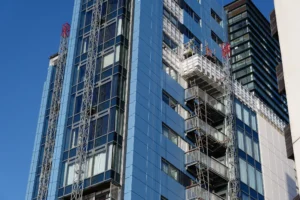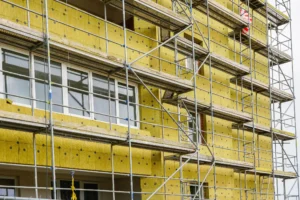Façade engineering and cladding have emerged as some of the most technically challenging, creative, and rewarding areas of modern construction. As buildings evolve to meet higher standards of sustainability and safety, the façade is now a central element of architectural performance — and demand for skilled people has never been higher.
Whether you’re starting out, retraining, or seeking advancement, this article brings together advice from industry insiders — engineers, project managers, and consultants — on how to build a successful career in façades.
1) Why façades are the place to be
In 2025, the façade industry sits at the crossroads of architecture, sustainability, and technology.
Every major construction trend — from net-zero design and recladding programmes to digital construction and offsite manufacturing — involves façade specialists.
It’s a sector that values both creativity and rigour, where projects range from transforming skylines to improving safety and comfort in everyday buildings.
As one Technical Director told us: “The façade is where art meets engineering. It’s visible proof of everything we stand for — safety, performance, and design integrity.”
2) The career pathways available
The façade industry offers diverse and flexible career routes, depending on your interests and background.
| Pathway | Typical Roles | Skills Focus |
|---|---|---|
| Design & Engineering | Façade Engineer, CAD/BIM Technician, Design Manager | Structural analysis, materials science, thermal performance |
| Project Delivery | Project Manager, Site Supervisor, Installation Lead | Construction sequencing, health & safety, logistics |
| Fire & Compliance | Fire Engineer, QA/Compliance Officer, Building Control Advisor | Regulation, testing, documentation, safety assurance |
| Consultancy & Inspection | Façade Consultant, Surveyor, Condition Assessor | Defects diagnosis, recladding, performance reporting |
| Sustainability & Innovation | Sustainability Engineer, BIPV Specialist, Product Developer | Embodied carbon, renewable integration, materials R&D |
The sector rewards versatility — engineers who understand site realities, or project managers with an eye for technical detail, progress fastest.
3) Advice from industry professionals
🎓 “Learn the principles early.”
“You can pick up software later, but understanding loads, materials, and fire performance will carry you through your whole career.”
— Senior Façade Engineer, London
📈 “Don’t be afraid to move between disciplines.”
“I started in architecture, moved into project delivery, and now work in façade consultancy. Each step gave me a new perspective.”
— Façade Consultant, Manchester
🧱 “Know your site.”
“Even if you’re office-based, get out and see installations. The best designers understand what’s practical.”
— Cladding Project Manager, Birmingham
💡 “Stay ahead of technology.”
“Digital tools, BIPV, modular façades — the industry is changing fast. Continuous learning keeps you valuable.”
— Technical Director, National Contractor
4) Key skills that define success
⚙️ Technical competence
A strong understanding of structural behaviour, materials science, and thermal performance is fundamental. This can be built through degree study, CPD, or on-the-job learning with senior engineers.
🧭 Regulatory awareness
Knowledge of the Building Safety Act, Approved Document B, and CWCT standards is essential. Even junior roles benefit from basic awareness of fire and compliance principles.
💬 Communication & collaboration
Façades bring together multiple disciplines — engineers, architects, installers, regulators — so teamwork and clarity are critical.
🌍 Sustainability literacy
Understanding energy efficiency, embodied carbon, and materials lifecycle will soon be as important as technical design itself.
5) Professional development and accreditation
The best careers in façades are built on continuous learning. Key routes include:
-
Membership of the Society of Façade Engineering (SFE) — a mark of professional recognition.
-
CWCT training and certification — covering testing, design, and best practice.
-
IstructE or CIBSE membership — for structural and environmental engineers respectively.
-
Fire Safety training (IFE, NEBOSH Fire, or Level 4 qualifications) — increasingly sought after.
-
BIM and digital coordination courses — essential for modern design environments.
“You don’t need to know everything at once,” one façade manager advised. “But show curiosity, reliability, and a willingness to learn — the rest follows naturally.”
6) Career progression: what to expect
Early career (0–3 years):
Graduate, technician, or trainee engineer roles focused on drawing, detailing, and calculations. You’ll gain exposure to systems, standards, and design tools.
Mid-career (3–10 years):
Move into lead design, project management, or compliance positions. By now you’ll be running packages or managing interfaces with clients and suppliers.
Senior career (10+ years):
Progress into associate or director-level roles, overseeing teams, mentoring juniors, and driving innovation or business growth. Some professionals move into consultancy or academia.
Specialisation options:
Fire engineering, sustainability, digital design, or façade remediation — all offer routes to niche expertise and leadership.
7) How to stand out to employers
✅ Show evidence, not adjectives.
Quantify your impact — e.g. “Delivered £3m recladding project ahead of schedule” or “Reduced façade defects by 25% through QA improvements.”
✅ Demonstrate compliance literacy.
Even basic awareness of the Building Safety Act or Golden Thread documentation sets you apart.
✅ Be curious.
Ask questions, visit factories, attend CPD events — curiosity is the best indicator of long-term potential.
✅ Connect with specialists.
Build relationships with recruiters who understand façade roles and can help you position your skills for maximum visibility.
8) Why now is the time
Between regulatory reform, sustainability targets, and technological innovation, façades are entering a golden era of opportunity.
There are clear skill gaps, high job security, and meaningful work improving building safety and energy performance.
If you’re looking for a career that blends design, science, and social impact — façades deliver all three.
🌱 Green Carbon Partners: Building the Next Generation of Façade Professionals
At Green Carbon Partners, we connect talent with purpose. Whether you’re a graduate taking your first step or an experienced project lead seeking your next challenge, we understand the pathways, certifications, and employers that define façade success. Together, we’re building safer, smarter, and more sustainable cities — one façade at a time


